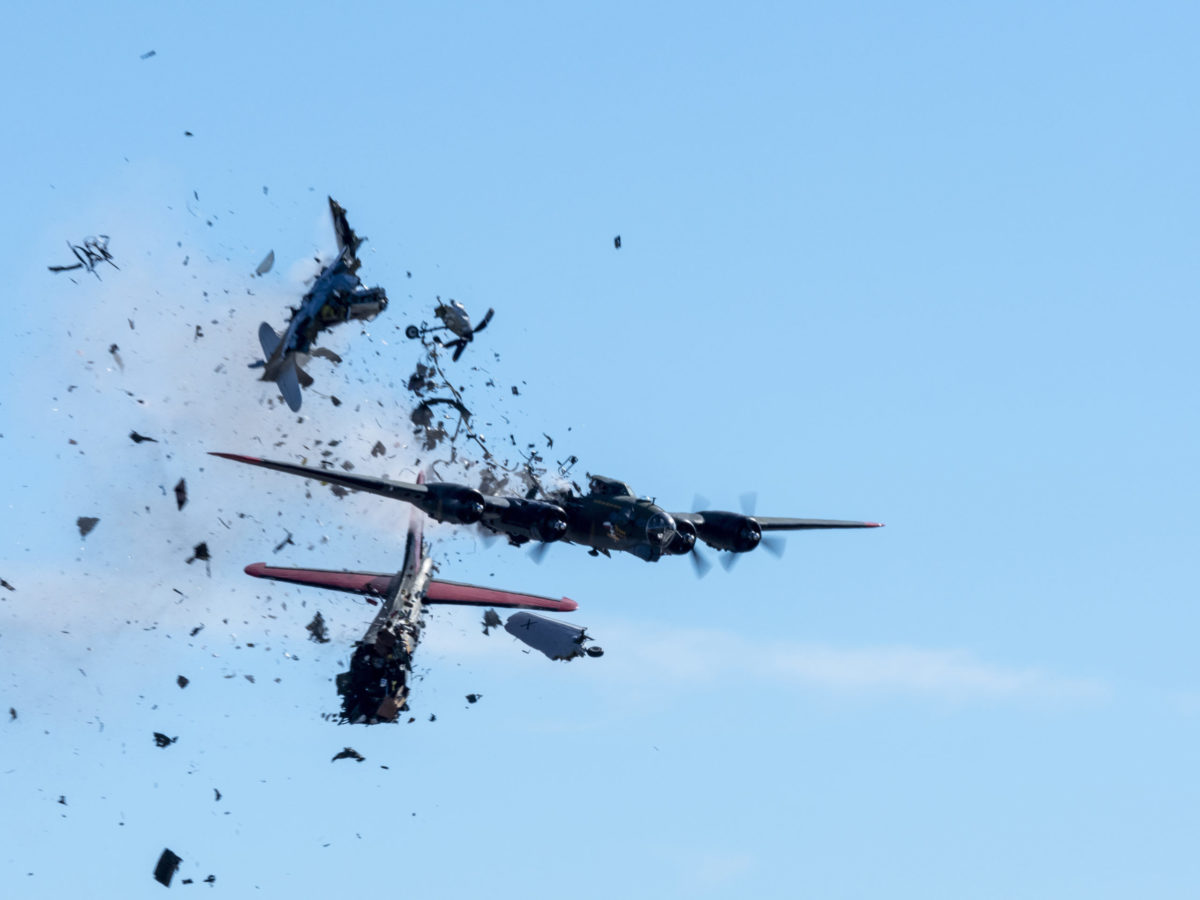A fiery crash on November 12, 2022, at the Wings Over Dallas airshow at Dallas Executive Airport in Texas killed six people and destroyed two World War II-era airplanes, a Bell P-63F Kingcobra and a Boeing B-17G Flying Fortress. All six people aboard the airplanes (the Kingcobra’s pilot and five crewmembers on the B-17) were killed in the accident. No one on the ground was injured. The accident happened at 1:22 p.m. and stunned the airshow audience and shocked the aviation and warbird communities.
The airplanes, both owned and operated by the American Airpower Heritage Museum, an affiliate organization of the Commemorative Air Force (CAF), were flying for the Saturday-afternoon airshow crowd in a formation that included three World War II fighter aircraft (the P-63 and two North American P-51 Mustangs) and three bombers (the B-17, a Consolidated B-24 Liberator and a North American B-25 Mitchell). For reasons that remain unexplained, the Kingcobra collided with the B-17, severing its tail. Both airplanes crashed to the ground in flames. The National Transportation Safety Board and the Federal Aviation Administration are investigating the cause of the accident.The CAF announced that the men who died in the crash were Craig Hutain, piloting the P-63, and Terry Barker, Kevin Michels, Dan Ragan, Leonard Root and Curtis Rowe aboard the B-17. Hutain was a pilot for United Airlines and Root and Barker had both retired from American Airlines. Ragan, it was reported, had once served in the B-17 when it flew for the U.S. Navy; Rowe had belonged to the Ohio Wing of the Civil Air Patrol for more than 30 years, and Michels can be seen on Facebook conducting a tour of the B-17.
The B-17 was a G model that the CAF flew as “Texas Raiders” and was one of only nine B-17s that were still airworthy out of the nearly 13,000 built. The airplane was manufactured by Douglas Aircraft (under license to Boeing) in Long Beach, California, and was accepted by the U.S. Army on July 16, 1945. In 1947 it was converted to a radar-equipped PB-1W and began serving with the U.S. Navy to fly airborne early warning missions. Placed into storage after its retirement from the Navy in 1955, the B-17 later entered private service flying cargo and as a camera plane.The Confederate Air Force, as it was known then, purchased the airplane in 1967. From 1983 until 1986 the airplane underwent a complete restoration to return it to wartime configuration. The airplane underwent another cycle of work to repair corrosion and other problems from 2001-2009, at the cost of $700,000. The airplane was repainted in 2017 and received necessary upgrades throughout the last years, the last an avionics upgrade in March 2021.
The Bell P-63 Kingcobra that crashed was a rare F model, one of only two built and the only one surviving. The Kingcobra was not one of World War II’s more successful airplanes. It looked much like its predecessor, Bell’s P-39 Airacobra, but had been almost completely redesigned. Still, the U.S. Army Air Forces was not pleased with its performance and most of the Kingcobras—2,397 of the 3,303 made—ended up flying for the Soviet Union as part of the Lend-Lease program. “The same features that made the P-63 such a handsome machine—no external radiator scoops, tricycle gear, a buried mid-engine—made it a lousy fighter,” wrote Aviation History contributing editor Stephan Wilkinson when he covered the airplane’s return to the air in 2016, after it had been damaged during a 2013 wheels-up landing.
The Dallas accident is certain to revive the ongoing debate over whether people should continue flying historic but increasingly rare airplanes.
historynet magazines
Our 9 best-selling history titles feature in-depth storytelling and iconic imagery to engage and inform on the people, the wars, and the events that shaped America and the world.






